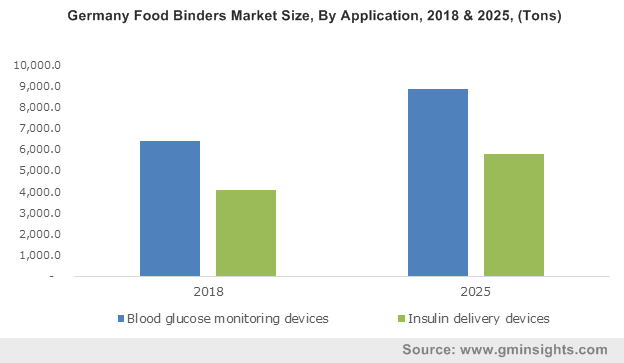Diabetes care devices market to derive substantial revenue via the launch of technologically-advanced monitoring devices over 2019-2025, massive investments in R&D activities to drive industry growth
Publisher : Fractovia | Published Date : 2019-06-04Request Sample
The revenue graph of the diabetes care devices market has been witnessing considerable momentum in the recent years owing to the increasing usage of self-monitoring blood glucose and insulin delivery devices. Obesity, smoking, genetic mutations, sedentary lifestyle, unhealthy diet have led to an escalation in the number of diabetes patients. The occurrence of diabetes is gradually rising, such that more than 1 in every 10 adult individuals or 12.2% of the U.S. population aged 18 years or older is affected with it. Diabetes is considered as the seventh leading cause of death.
U.S. Diabetes Care Devices Market, By Product, 2018 & 2025 (USD Mn)

According to WHO, 422 million adults globally are diabetic patients, 1.6 million deaths are directly attributed to diabetes each year and 1 in 3 adults aged over 18 years is overweight and 1 in 10 is obese. In essence, all these statistics demonstrate the rapid growth in number of diabetic patients which has driven the growth prospects of the diabetes care devices industry. According to a research report by Global Market Insights, Inc., the revenue portfolio of diabetes care devices market will exceed USD 41.5 billion by 2025.
Diabetes is increasing among adults as well as children due to the prominence of an indolent lifestyle. In 2016, 41 million infants and young children were reported to be obese or overweight, 124 million children and adolescents were obese which counts to be a tenfold increase in the last four decades and nearly 1 in 5 children and adolescents are overweight or obese. Obesity is the primary cause which has led to the prevalence of diabetes as almost everyone prefers to enjoy unhealthy lifestyle without realizing the significance of physical wellness. As per the Pan American Health Organization (PAHO), around 305,000 people died due to type 2 diabetes in America in the year 2014.
Increasing count of deaths due to diabetes has intensified the sales of diabetic care devices. The latest technologies and devices are being preferred over traditional techniques due to their ability to deliver accurate results. Launched recently, Senseonics’s Eversense Continuous Glucose Monitoring (CGM) system is one such unique and revolutionary device. Termed as the first implantable device to measure glucose level, Eversense CGM has received approval from the U.S. Food and Drug Administration (FDA) which is being touted as a groundbreaking step forward in the dynamic diabetes management world.
The device uses a unique light-based technology to send glucose level data to an app on cell phone, warning patients about their rising or dropping glucose level. It can be worn up to 90 days which is impressive as Dexcom and Medtronic’s sensor technology can be used for up to 10 days only. Eversense CGM is one of many innovations unveiled by medical device makers to check on diabetes and demonstrates the enormous growth opportunities being opened up for the diabetes care devices industry.
Numerous innovations in the healthcare sector have ensured that several options and product ranges are available to keep a check on diabetes. Many of these are in the pipeline and are awaiting regulatory approval. For instance, a ready-to-use glucagon emergency pen by Xeris Pharmaceuticals is awaiting regulatory approval from FDA depending upon the meeting in June 2019. Apparently, there are a number of devices in the early production phase or are seeking FDA approval – a factor that would benefit the growth prospects of diabetes care devices market.
Moreover, myriad studies are being carried out today to find out new approaches to manage diabetes. For instance, the Juvenile Diabetes Research Foundation (JDRF) is a non-profit organization which offers funding to cure type 1 diabetes (T1D). The organization has invested over $2.2 billion in research funding since its inception. A T1D patient Lindsey Redepenning is a commendable example of recovery through Medtronic 670g Artificial Pancreas hybrid closed-loop system developed with the contribution of JDRF. Implantation of artificial pancreas is a new technology which effectively helps in curing T1D by releasing insulin in with changing blood glucose levels in a similar way to a human pancreas.
In a nutshell, rising number of R&D investment and consistent efforts of the non-profit organizations like JDRF will propel diabetes care devices market share. Additionally, the launch of technologically-superior and highly efficient blood glucose measuring devices is likely to assist the diabetes care devices market in registering exponential growth in the times to come.